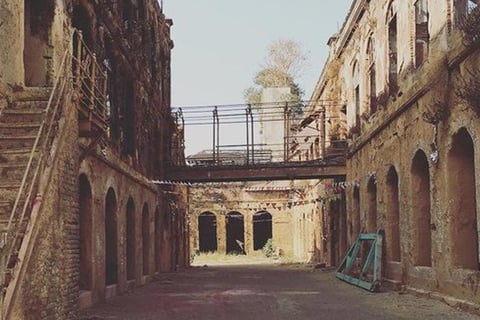This website is available in Hindi or English language
Mukesh Mills Mumbai
On a dark and moonless night, the ruined façade of Mukesh Mills and its minaret-like shuttered chimney are an eerie reminder of the Mumbai that was once Bombay. Its blackened window arches reflect the dark night sky, a jagged, otherworldly blot on a modern metropolis.
Trending Videos
Kolkata’s Most Famous Dishes
It’s been decades since Colaba’s iconic Mukesh Mills fell into disrepair after a fire, but images of its ruined roofs, moss-laden walls and boarded-up windows still appear on “Mumbai’s Most Haunted” lists. The mill complex has been closed since 2019, when the BMC issued a notice saying its structure had become too weak. Yet, rumours say the mill still has tenants of the… otherworldly variety. These “ghosts” are believed to still linger in its empty corridors. And those who walk into the mill premises often witness unexplained phenomena such as strange sounds, echoing footsteps and moving shadows.
Mukesh Mills
The story of Mukesh Mills has all the makings of a great Bollywood masala blockbuster – it has ghosts, history, drama and also stars a popular (not to be named) yesteryear actor.
Mill by the Sea
Textile mills flourished in the then Bombay in the 1850s, thanks to businessmen Cowasjee Nanabhoy and Edwin Haycock. In the heyday of cotton production in Bombay, there were hundreds of mills in the city. One of these was Mukesh Mills, which is believed to have been set up in the late 1800s and early 1900s in the neighbourhood of Colaba. It was the only mill in South Bombay at the time and was located in a spectacular location by the sea.
According to Kevan Umrigar of Khaki Tours, Mumbai, the name Mukesh Mills is a recent addition. “It was originally called Colaba Mills and belonged to the Colaba Land and Mill Company, which was in the business of reclaiming land in Colaba for warehouses. At the time, the area was being developed as a cotton port,” he says.
Mukesh Mills
When Mukesh Mills was set up, no one could have imagined the tragedy that was to follow. At the time, the milling business in Bombay was flourishing. The city was exporting more cotton to Britain than ever before and this trade was benefiting not just the mills but also the port of Bombay. And Mukesh Mills, like many others, was part of this success story.
However, this was not destined to happen and with growing labour crisis and exploitation leading to conflict between the mill workers and owners and following the Bombay Mill Workers Strike of 1929 and the economic fallout of World War II, the mills gradually declined and the last mill closed in 2000.
The downfall of Mukesh Mills was even more rapid and its end came earlier than its counterparts. And in some ways, it was even more tragic. A devastating fire in 1982 burned down the mill and many mill workers trapped in the building died a horrific death. Following this incident, the mill was completely abandoned. And then the first rumours of hauntings began.
Bollywood's Nightmare at Mukesh Mills
While the original owners could not have predicted the mill's downfall, its unexpected popularity thereafter must have been even more shocking. After being subjected to the elements for a long time, this atmospheric ruin found a second life on screen. And its real walls became the material of fantasies on reel. From choreographed song and dance set pieces to action-packed film climaxes, Mukesh Mills became a favourite in the 1990s, especially among Bollywood location scouts. Many Hindi films—from the iconic “Jumma Chumma” song from Amitabh Bachchan’s film Hum to the high-octane action sequences of Pooja Bhatt-Sanjay Dutt’s film Sadak, and more recent films like Tiger Shroff’s action debut Heropanti—have been shot at this ruined mill. Portions of Shah Rukh Khan’s superhit film Om Shanti Om were also shot here, a film that coincidentally involved a villain named Mukesh and a burnt and haunted film set. And if you look closely at the frames of all the above.
### Mukesh Mills, Mumbai: A Haunting History
. To delve into the mill’s history and the reasons for its popularity – the ghosts that lurk inside.
#### The ffback
Mukesh Mills is located in Mumbai which was established in 1870 by the East India company personnel to encourage textiles. In its years of service, the mill was alive with the hustle and bustle of men and machinery, churning out cotton及及 fabrics for different regions of the country. Unfortunately, in the year 1982, a mysterious fire changed everything – the mill was half burnt and all that remains today is the archaic and seemingly abandoned structure. It was also abandoned after that, and its ghostly reputation has increasingly popularized.
A lot of us blame it on an accident, while few claim it was done on purpose. But anyway, the eerie remains of the mill are now doing the rounds as an infamous haunted place. Myths, stories, and eye-witness accounts, and quite a few tales of ‘ghosts’ infesting the place have made many think that Mukesh Mills is indeed haunted.
#### The Haunting Resistance Campaign And Paranormal Incidents
The Mukesh Mills’ history suggests that like many old buildings in India, this house too has ghosts. Many security guards and workers employed at Mukesh Mills have narrated typical ghost stories of how there is always something unusual happening around the mill. Most cinematographers who have worked on site report peculiar sounds and movements, and ghost-like images appearing in the frame. A number of people who have been to the place, full especially of darkness, at night, have turned deaf as they say sickening sounds pervaded the environment and warm little shadows glided stealthily around,or feeling an overwhelming sense of unease.
One of the most persistent stories is of an actress, who, while shooting at the mill, became ‘possessed’ and started speaking in a different voice. The crew members were said to have difficulty relaxing her, and the episode was so traumatic that the shooting was called off. This accounts among many others, have made Mukesh Mills a spine chilling place in Mumbai's film business as many actresses and actors have refused to shoot there once it is dark.
The Disturbing Ambiance of the Mill Mukesh Mills’ eerie ambiance adds to its haunted aura. The structure is weather beaten, its walls mossy with graffiti, and considerable parts of the building have been overgrown. Within, the sight of decaying staircases, empty arches and motionless air fills one with a creepiness. In fact, Mukesh Mills feels estranging even with all the extra sunshine one can get; there is a deadening calm that Mukesh Mills maintains, which is unlike any other region of the city with this much activity.
Visitors often talk about a feeling of ‘being watched’ and describe unusual temperature drops in specific areas of the mill. Some individuals who have dared to delve further within its confines allege that electronic gadgets such as cameras and cellular phones frequently cease to function inexplicably which enhances the stories of other-wordly presence.
Mukesh Mills in Popular Culture and Media
Mukesh Mills has drawn a lot of attention from the media and film industry in normal course or we can say contrary to normal course due to its haunted image. The media and film industry have extensively used the mill in Bollywood movies, music videos, and TV shows alike over the years. Movies like Kabhi Haan Kabhi Naa, Om Shanti Om and Ghulam have all made good use of the creepy atmosphere of Mukesh Mills and have successfully captured its horror portrait in films.
There is something in particular about the site which attracts filmmakers, and that is the austere and unpretentious beauty of the area which provides an extraordinary irrespective of other backdrops. Though, various crews have agreed to work only in day time and even that is in a group fearing local stories and past incidents, nighttime shoots have always been a challenge. This combination of the psyche of people brings to the fore Mukesh Mills which is a much cherished but an eerie spot in the city of Mumbai.
Best Time to go to Mukesh Mills
Mukesh Mills also known Mukesh Mill in Colaba, Mumbai attracts tourists despite safety disclaimers especially from the thrill seekers and those interested in the paranormal where relevant restrictions are lifted. Best visit is done during the sunlight since the site is generally considered dangerous with a risk of mugging or even worse psychos after sunset. When the daylight is around, one is able to enjoy the weird architecture’s weirdness without as much of the weirdness that people seem to experience during the night time visits.
Conclusion
Mukesh Mills in Mumbai has not remained an ordinary mediocre shelled building because it has blossomed into a nexus of myths where uncanny fascinating stories abound. The breach and oppression of its history along with its availability of disturbing ambience and paranormal activity makes it one of the most haunted places within the city. For many centuries ghost stories that engaged Mukesh Mills, along with others, saw them getting marked by historical past while realities of paranormal activity overshadowed the modern day.
There is no scientific evidence that proves its haunted status; however the stories shared by the locals, actors and security guards keep the mystery intact and for many, it remains an enigma. Even for those who are interested in the supernatural or the haunted places of Mumbai, Mukesh Mills is an Everlasting hair-raising mystery. Whether it is justified as a historical location or place of paranormal activity, this is one place that has the ability to horrify and excite in equal proportions and is therefore inescapable.


